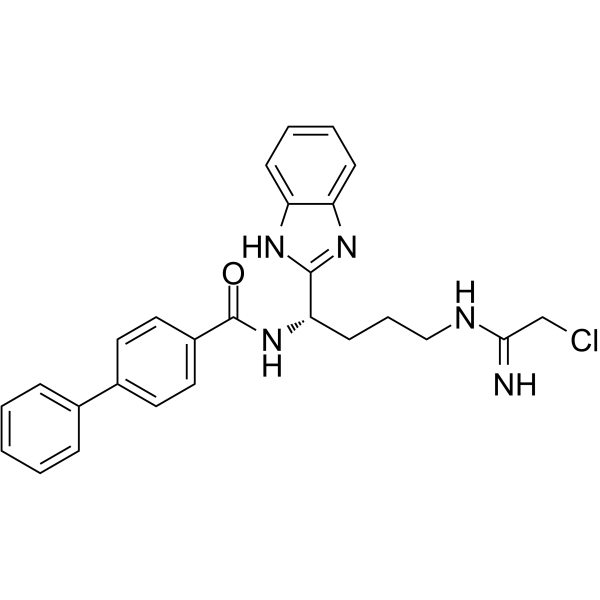
BB-Cl-Amidine is a peptidylarginine deminase (PAD) inhibitor. BB-Cl-amidine subtly reduces splenomegaly in MRL/lpr mice, while there is a trend towards increased circulating levels of anti-NET antibodies with PAD inhibitor treatment. However, neither PAD inhibitor affected body weight or total IgG levels. Indeed, treatment with both Cl-amidine and BB-Cl-amidine significantly improves endothelium-dependent vasorelaxation. The BB-Cl-amidine group also shows a strong trend towards downregulation of IRGs. Treatment with either Cl-amidine or BB-Cl-amidine significantly improves muzzle alopecia, in many cases preventing it entirely.
| Molecular Weight | 459.97 |
| Formula | C26H26ClN5O |
| CAS Number | 1802637-39-3 |
| Solubility (25°C) | DMSO ≥ 100 mg/mL |
| Storage | 4°C, dry, sealed |
| Species | Mouse | Rat | Rabbit | Guinea pig | Hamster | Dog |
| Weight (kg) | 0.02 | 0.15 | 1.8 | 0.4 | 0.08 | 10 |
| Body Surface Area (m2) | 0.007 | 0.025 | 0.15 | 0.05 | 0.02 | 0.5 |
| Km factor | 3 | 6 | 12 | 8 | 5 | 20 |
| Animal A (mg/kg) = Animal B (mg/kg) multiplied by | Animal B Km |
| Animal A Km |
For example, to modify the dose of Compound A used for a mouse (20 mg/kg) to a dose based on the BSA for a rat, multiply 20 mg/kg by the Km factor for a mouse and then divide by the Km factor for a rat. This calculation results in a rat equivalent dose for Compound A of 10 mg/kg.
| Related PAD Products |
|---|
| PAD4-IN-2
PAD4-IN-2 is a PAD4 inhibitor (IC50=1.94 μM). |
| Cl-amidine
Cl-amidine is an orally active peptidylarginine deminase (PAD) inhibitor, with IC50 values of 0.8 μM, 6.2 μM and 5.9 μM for PAD1, PAD3, and PAD4, respectively. Cl-amidine induces apoptosis in cancer cells. Cl-amidine induces microRNA (miR)-16 (miRNA-16, microRNA-16) expression and causes cell cycle arrest. Cl-Amidine prevents histone 3 citrullination and neutrophil extracellular trap formation, and improves survival in a murine sepsis model. |
| GSK106
GSK106 is an inactive control for the selective PAD4 inhibitors, GSK484 and GSK199. |
| BMS-P5 free base
BMS-P5 free base is a specific and orally active peptidylarginine deiminase 4 (PAD4) inhibitor. BMS-P5 free base blocks MM-induced NET formation and delays progression of MM in a syngeneic mouse model. |
| BMS-P5
BMS-P5 is a specific and orally active peptidylarginine deiminase 4 (PAD4) inhibitor. BMS-P5 blocks MM-induced NET formation and delays progression of MM in a syngeneic mouse model. |


Products are for research use only. Not for human use. We do not sell to patients.
© Copyright 2010-2023 AbMole BioScience. All Rights Reserved.
